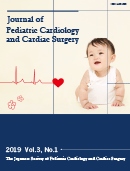Volume 3, Issue 1
Displaying 1-11 of 11 articles from this issue
- |<
- <
- 1
- >
- >|
Original Articles
-
2019Volume 3Issue 1 Pages 1-7
Published: January 31, 2019
Released on J-STAGE: March 18, 2021
Download PDF (227K) -
2019Volume 3Issue 1 Pages 8-13
Published: January 31, 2019
Released on J-STAGE: March 18, 2021
Download PDF (107K) -
2019Volume 3Issue 1 Pages 14-19
Published: January 31, 2019
Released on J-STAGE: March 18, 2021
Download PDF (2799K) -
2019Volume 3Issue 1 Pages 20-27
Published: January 31, 2019
Released on J-STAGE: March 18, 2021
Download PDF (6046K) -
2019Volume 3Issue 1 Pages 28-34
Published: January 31, 2019
Released on J-STAGE: March 18, 2021
Download PDF (6608K)
Case Reports
-
2019Volume 3Issue 1 Pages 35-38
Published: January 31, 2019
Released on J-STAGE: March 18, 2021
Download PDF (1319K) -
2019Volume 3Issue 1 Pages 39-43
Published: January 31, 2019
Released on J-STAGE: March 18, 2021
Download PDF (4793K)
Original Articles
-
2019Volume 3Issue 1 Pages 44-49
Published: January 31, 2019
Released on J-STAGE: March 18, 2021
Download PDF (583K) -
2019Volume 3Issue 1 Pages 50-55
Published: January 31, 2019
Released on J-STAGE: March 18, 2021
Download PDF (2128K) -
2019Volume 3Issue 1 Pages 56-60
Published: January 31, 2019
Released on J-STAGE: March 18, 2021
Download PDF (792K)
Images in Pediatric and Congenital Heart Disease
-
2019Volume 3Issue 1 Pages 61-62
Published: January 31, 2019
Released on J-STAGE: March 18, 2021
Download PDF (2865K)
- |<
- <
- 1
- >
- >|
